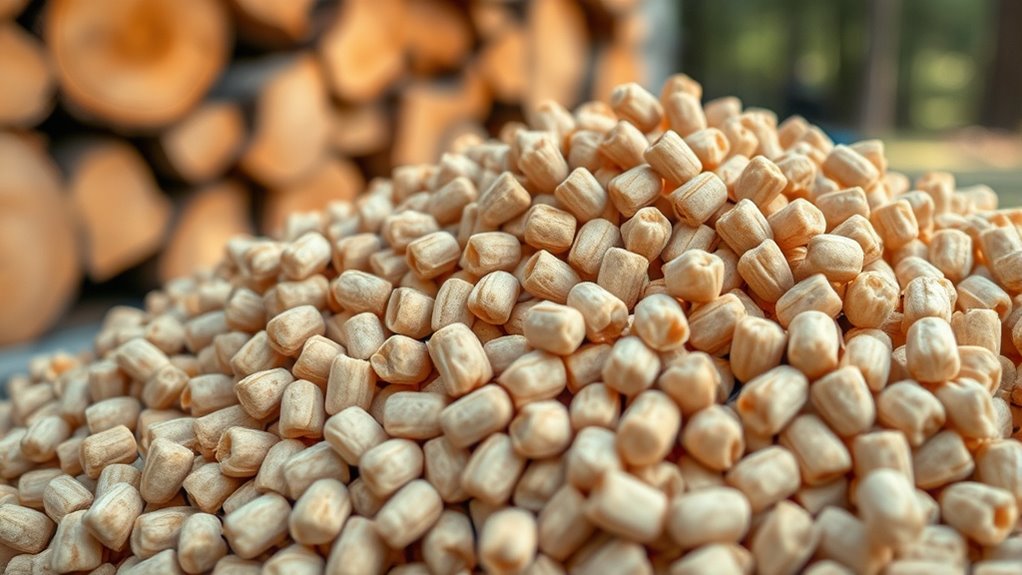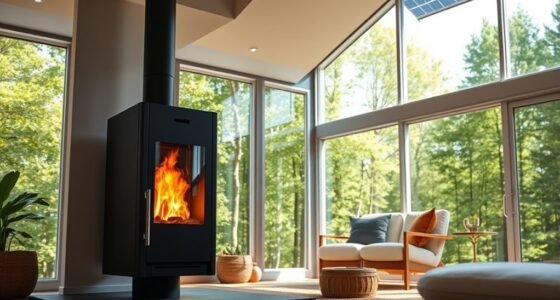Using pellets made from sawdust is a smart choice for renewable fuel. These compressed biomass cylinders help reduce reliance on fossil fuels and cut down greenhouse gas emissions. Plus, they make good use of waste materials that would otherwise be discarded or burned. Sawdust pellets are easy to store, handle, and burn cleanly in many heating systems. If you want to discover more about how they support sustainable energy efforts, keep exploring what this eco-friendly fuel has to offer.
Key Takeaways
- Sawdust pellets are a renewable fuel derived from compressed organic waste, reducing reliance on fossil fuels.
- They produce fewer pollutants and are considered carbon-neutral, supporting environmental sustainability.
- Pellet manufacturing utilizes wood waste, promoting waste management and circular economy principles.
- Sawdust pellets are versatile, easy to store, and compatible with existing heating systems.
- Using these pellets helps mitigate climate change and promotes renewable energy adoption worldwide.

Have you ever wondered how we can reduce our reliance on fossil fuels and protect the environment? One promising way is through biomass combustion, especially by creating pellets from sawdust. These pellets are an excellent example of sustainable energy because they utilize waste materials that would otherwise be discarded or burned openly, releasing harmful emissions into the atmosphere. When you think about biomass combustion, you’re considering a process that turns organic waste into a clean, efficient fuel source, making it a smart alternative to traditional fossil fuels. Using sawdust for pellet production not only helps manage waste effectively but also reduces the need for non-renewable energy sources.
Reducing reliance on fossil fuels with sawdust pellets promotes sustainable energy and environmental protection.
Sawdust pellets are made by compressing finely ground wood particles into dense, uniform cylinders that burn cleanly and efficiently. As you use these pellets for heating or energy production, you’re participating in a cycle that supports renewable energy goals. Unlike coal or oil, which take millions of years to form, biomass is constantly replenished through sustainable forestry practices. When managed responsibly, harvesting sawdust for pellets doesn’t harm forests or deplete resources. Instead, it encourages a circular economy where waste becomes a valuable resource, reducing landfill waste and greenhouse gas emissions from decomposition or open burning.
By choosing biomass combustion with sawdust pellets, you’re contributing directly to a greener future. This form of renewable fuel produces markedly fewer pollutants, such as sulfur dioxide and particulate matter, compared to fossil fuels. Plus, because the carbon released during combustion was recently captured from the atmosphere by trees, the process is considered carbon-neutral, helping to combat climate change. This makes pellets from sawdust a powerful tool in shifting to sustainable energy systems. They are versatile, easy to store, and can be used in existing heating systems with minimal modifications. As you switch to biomass pellets, you’re also supporting local economies by creating jobs in pellet manufacturing and forestry management.
Incorporating biomass combustion into your energy consumption is a practical step toward sustainability. It reduces dependence on finite resources and promotes cleaner air quality. As governments and communities push for renewable energy adoption, biomass pellets from sawdust stand out as an accessible, efficient, and environmentally friendly option. You get the benefits of a renewable energy source that is both cost-effective and eco-conscious, aligning with global efforts to combat climate change. Moving toward biomass energy, especially through innovative solutions like sawdust pellets, helps you make a meaningful difference in building a more sustainable world. Additionally, utilizing proper storage techniques can extend the shelf life and efficiency of the pellets, ensuring optimal performance and safety.
Frequently Asked Questions
Are Pellet Stoves Energy-Efficient Compared to Traditional Heating Methods?
Pellet stoves are generally more energy-efficient than traditional heating methods because they convert more fuel into heat. You’ll notice cost savings over time due to their high efficiency and low fuel costs. When considering installation, guarantee proper venting and space for fuel storage. While initial setup might be higher, the long-term savings and consistent warmth make pellet stoves a smart, eco-friendly choice for your home.
How Long Does It Take to Produce a Ton of Sawdust Pellets?
Think of the production timeline as a steady river flowing from raw sawdust to a ton of pellets. It typically takes about 24 to 48 hours for pellet manufacturing to produce a ton, depending on equipment and process efficiency. The journey involves drying, grinding, and compressing sawdust, transforming it into compact, energy-packed pellets. Your patience fuels this transformation, turning raw materials into a sustainable heating source.
What Are the Environmental Impacts of Large-Scale Pellet Manufacturing?
You might wonder about the environmental impacts of large-scale pellet manufacturing. It can increase your facility’s environmental footprint through energy use and emissions, but if managed well, it supports resource sustainability by utilizing sawdust that would otherwise go to waste. By adopting eco-friendly practices and renewable energy sources, you can minimize negative effects, ensuring your pellet production remains environmentally responsible and sustainable in the long run.
Can Sawdust Pellets Be Used in Existing Residential Heating Systems?
Yes, sawdust pellets can be used in existing residential heating systems, provided they have sawdust pellet compatibility. You should check if your stove or furnace supports pellet types and sizes. Residential pellet integration is usually straightforward if the system is designed for pellet fuel. Always follow manufacturer instructions to guarantee safe and efficient operation, and consider using high-quality pellets for ideal performance and minimal ash buildup.
What Is the Typical Lifespan of Pellet-Burning Equipment?
You can expect pellet-burning equipment to last around 10 to 15 years with proper care. Its durability depends on regular maintenance, like cleaning the burn pot and inspecting the auger system. Neglecting maintenance can shorten its lifespan. Investing in quality equipment and following manufacturer guidelines ensures peak performance and longevity, allowing you to enjoy efficient heating while minimizing repair costs over the years.
Conclusion
As you explore the world of renewable fuels, think of sawdust pellets as gentle whispers of sustainable hope, quietly transforming waste into warm comfort. They’re like tiny, glowing embers that light the way toward a cleaner future, blending nature’s kindness with your daily needs. Embracing these humble sources allows you to nurture the environment without shouting, softly guiding us all toward a more balanced and greener tomorrow.











